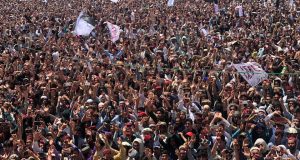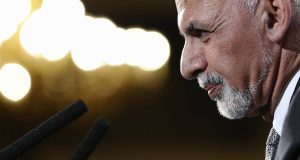Pata Khazana (The Hidden Treasure): A haze of controversy surrounds the ancient jewel of Pashto Literature
(Observations by: Angelina Merisi)
One would expect to find some level of controversy, surrounding an obscure, archaic manuscript found in an old village Mosque in 1886, subsequently claimed to disclose Pashto poems and biographical sketches from the eighth century straight down through the eighteenth century. There is nothing unusual about this phenomenon, considering most ancient discoveries will inevitably face mass scrutiny, an authentication process, sifted through a barrage of scientific and academic examinations until a consensus is reached or at least, enough evidence gathered to silence many opposing opinions. Such is the ongoing case concerning ‘Abdul Hay Habibi’s watershed annotations to the tazkira manuscript Pata Khazana (The Hidden Treasure), (1) not to mention further doubts concerning the authenticity of the original manuscript itself!
Similarly, a craze of allegations arose in 1857, when American writer Delia Salter Bacon published The Philosophy of the Plays of Shakespeare, in which she argued that Lord Francis Bacon, among others, wrote Shakespeare’s plays.
While arguments continue to ensue pertaining to the authenticity of Pata Khazana, in this article I have chosen to accept the book at face value in an effort to simply describe its contents, along with quoting two examples of poetry disclosed within this anthology.
The original book was written in Qandahar in 1141-42 H. (1728-29 A.D.) by Mohammad Hothek under the patronage of the emperor Shah Hussain, a man keenly interested in promoting and preserving Pashto literature and culture. The Author of Pata Khazana was clearly a great scholar of the Pashto language and an eminent literary personality of the court. (2) A hand-written manuscript transcribed in 1886 was discovered and further annotated and translated by Professor Abdul Hay Habibi in 1944.(3)
The original book by Mohammad Hothek is made up of three parts. The first section is dedicated to the life and work of various early poets from 100 H. (718 A.D.) to 1,000 H. The second part is concerned with contemporary poets, and part three is dedicated to female poets of the Pashto language followed by a conclusion. At the end of the book, the author briefly discusses his own life and work.
In the 1944 version of the book, Professor Abdul Hay Habibi includes detailed footnotes, annotations, historical notes and a commentary on the style and characteristics of Pashto prose and poetry. Interestingly, the fourth edition of the book, published in 1977, includes an account of Professor Habibi’s remarks on the “skeptics” of Pata Khazana, in which discloses discussions and opinions, expressed by various scholars and writers concerning authenticity. In this chapter, Habibi analyses a number of cases, one example being the suggested forgery of the poems by Mohammad Hothek, in an attempt to please his Monarch, Shah Hussain. Hay Habibi, however, critiques these opinions in a coherent, analytical fashion, and rather convincingly defends the work. (A further discussion and analysis of these claims will be addressed at a later stage, where I will discuss the work: Pata Khazana Pil Meezan (published in 1988); a major work which provoked discussion about Pata Khazana. Written by eminent scholar Qalandar Momand, the book provides analysis of content, background information, language and dates of the Pata Khazana and concludes that the book was fabricated by Habibi himself).
In his brief glance at the history of Pashto prose, Hay Habibi recounts that the ‘oldest document available in Pashto prose are the few pages of Tazkerat-al-Awlia (Memories of Saints) by Sulaiman Maku, written in 612 H. (1215 A.D.) during the time of the Mongol raids.” (4) Habibi states that Pashto prose was firmly established even before Akhund Darweza and Pir Roshan. During the time of the Mongols, he suggests that an overly adorned, unattractive style of prose became popular in Persia, devoid of the fluid composition of the past, resulting in complex phrases and twisted sentences resulting in loss of fluency. He further states that Pir Roshan’s Khair-al-Bayan was written in this crude style, using rhythmical prose with liberty. (5)
According to Hay Habibi, it was the father of the Pashto language, Khushal Khan Khattak who saved and resuscitated Pashto prose by adopting a classical style in his works. However, Hay Habibi resists acknowledging the work of Khushal Khattak as being completely responsible for the elimination of this ‘crude’ style, but instead argues that forty years after the death of Khushal Khattak, the author of Pata Khazana, (Mohammad Hothek), was the writer who fully revived Pashto prose to its former glory by writing in the fluid, simple, classic style of his ancestors.(6)
In his discussion concerning examples of poetry contained in the Pata Khazana, Hay Habibi singles out the work of Jahan Pahlavan Amir Krorr Suri where he states ‘from the viewpoint of vigor and style, pure Pashto words, meter and rhyme, it is a magnificent example of our literature.’ (7)This work, he states, proves that Pashto literature existed around 130 H. (752 A.D.) and therefore the Pashto language was refined during the first century of the Islamic era, and at that time was pure and free from foreign influence.
Hay Habibi discloses an exquisite account of the style and characteristics of Pashto poetry, including the influence of environment: ‘drawn by the power of creation to express feelings and talk about his environment and picture it in his lyrics.’ (8) Notably he recounts the traditional Pashtun notion of bravery and pride, in which he states ‘the gallantry of youths has been praised in poems and looked upon with pride for ages in our nation.’ (9) He further states that: description of scenery, love and fondness of beauty and family attachment are paramount features in Pashto literature.
The book offers a glimpse into various aspects of Pashtun social, cultural and tribal life. Lutz Rzehak states that “a Pashtun knows by heart at least all his forefathers up to the ancestor of his kahol group for seven or eight generations at a minimum.” (10) In introducing the poet Shaikh Mathi Ghoryakhel Sarhbanay, Mohammad Hothek introduces the poet by enumerating seven of his linking forefathers: Shaikh Mathi was the son of Abas, who was the son of Omar, who was the son of Khalil, who was the son of Ghorya, who was the son of Kand, who was the son of Khrasboon, who was a son of Hazrat Sarhbani.
One also comes across the odd quaint, entertaining anecdote in the book, which articulates the Pashtun love of friendship along with the typically wry Pashtun sense of humour. For instance, M. Hothek tells us that the poet: Mohammad Tahir Jamaryanel was known as the clever poet, who was “jovial with his friends and had a good sense of humour.” In this couplet, the poet teases his friend:
They say that conversation
Affects each other’s imagination,
For years you have talked wonky
It did not turn me into a donkey.
In a poem taken from the first ‘Treasure,’ Mohammad Hothek discloses a short, quaint biographical sketch of the poet, Shaikh Esa Meshwanay. While other poets are depicted as brave, valiant warriors, men of letters or mystical Shaikh’s with miraculous powers, Esa Meshwaney’s story is one of simplicity and portrays a brief account involving common ‘village gossip’ in which he is wrongfully accused by the locals, who approached the ruler Sher Shah, complaining of Esa’s wine drinking habits. The King’s men are subsequently ordered to visit Esa, where in fact, they find him drinking milk, and not wine, from a goblet. It is further disclosed that Shaikh Esa was a saint who wrote poetry. In this work, the poet contemplates a more universal preoccupation: that of man and his relationship with God. Written in very simple language, the poet raises questions regarding his own status as a mere mortal in light of the powerful Almighty. He despairs when he considers his relationship with God which at times seems to border on estrangement and what he perceives as abandonment by the creator.
First you accept me
Then you disavow,
Sometimes I am the lord
Later a destitute though.
You are all mighty
You rule the world entire,
Sometimes you enlighten me
Then you put me on fire.
Esa is confused and bewildered,
He knows not why this change,
Sometimes I am a friend
Then you declare me strange.
In the third ‘Treasure,’ Mohammad Hothek discloses biographical accounts of six female poets of the Pashto language. Halima, The Hafiza, was the daughter of Khushal Khan Khatak. It is stated that she was a learned woman who lived in chastity and never married. She knew the Qur’an by heart and taught other women in the house of her brother: In this simple, beautiful poem, Halima, The Hafiza expresses sentiments of profound love:
The mere thought of my love
Made me overwhelmingly elated,
I do not know if my happiness
To Mumtaz or Nour-Jahan can be related.
When I was honoured with your love
On that auspicious day,
I praised the compassionate Lord
In more than one way.
When the worldly love of Ayaz
My heart managed to disown,
I felt prouder than I would have
Sitting on Mahmud’s throne.
To everyone I look
I picture his face,
I am overwhelmed with joy
By his charming grace.
All other thoughts
Have left my weary mind,
Friends and foe alike
To me are one kind.
The Slanderer’s deception
Has reached a fearful pitch,
Be aware O Halima
Your love it may bewitch
The Pata Khazana is indeed a hidden treasure, offering rare insight into the lives and minds of early poets of the Pashto language. Filled with works expressed in simple format and language yet profoundly evocative of Islamic ideology, Pashtun tradition and custom, love of family, nation, battle and war. Still controversial with regard to origin and authenticity, this iconic work is nonetheless of major importance to understanding the dynamics of early Pashtun culture and society……a vision, and a priceless relic.
References:
- James Caron. “Reading the Power of Printed Orality in Afghanistan: Popular Pashto Literature as Historical Evidence and Public Intervention,” Journal of Social History, Oxford University Press, 2011.
- 2) A.H. Habibi, (Edition with commentary of Muhammad B.Daud B. Qader Khan Hotak), “The Hidden Treasure: Pata Khazana,” English Translation: Khushal Habibi, Lanham MD, 1997, p.2.
- Ibid, p.2
- Hay Habibi, Ibid, p. 7.
- Ibid, p. 8.
- Ibid, p. 9.
- Ibid, p. 12.
- Ibid, p. 14.
- Ibid, p.16.
- Lutz Rzehak, “ Doing Pashto,” Afghanistan Analysts Network, 2011, p.8.
All references, unless otherwise stated, taken from: A. H. Habibi, Pata Khazana, edition with commentary of Muhammad b. Daud b. Qader Khan Hothak, The Hidden Treasure: Pata Khazana, Eng. trans. Khushal Habibi (Lanham, MD, 1997). English translations of poetry by: Khushal Habibi.
Angelina Merisi is a writer and columnist with the Pashtun Times. She has a master degree in the study of Religions, and she has been studying Pashtun culture and society for six years.
THE PASHTUN TIMES
 Pashtun Times Latest News
Pashtun Times Latest News




